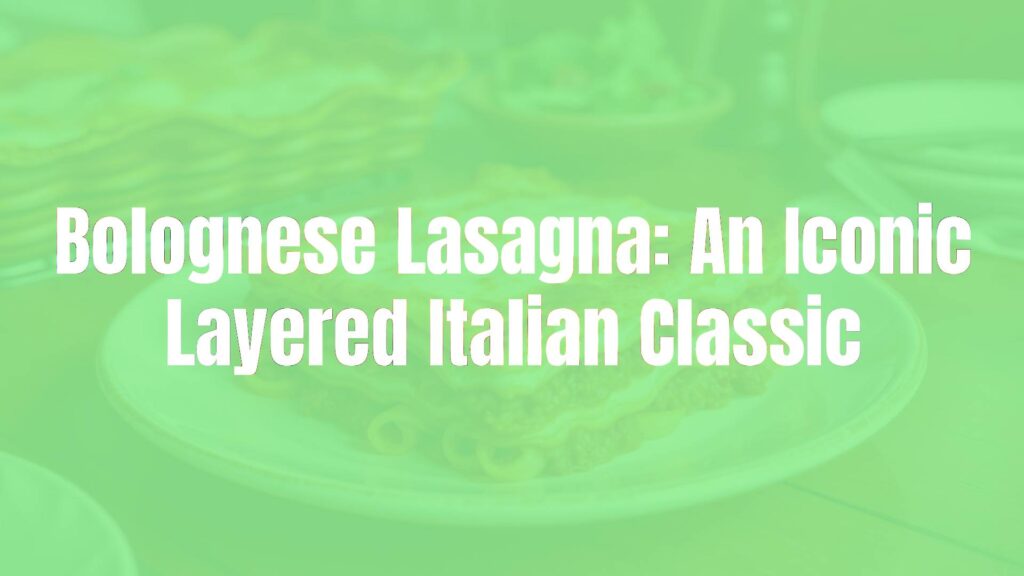Bolognese Lasagna: A Richly Layered Staple of Italian Cuisine
An Overview of Bolognese Lasagna
Bolognese lasagna, or Lasagne alla Bolognese, stands out as a quintessential example of Italy’s knack for comforting, layered baked dishes. This famed specialty from the city of Bologna melds egg pasta sheets, savory ragù, creamy béchamel, and grated cheese in a harmonious, oven-baked casserole. Its sumptuous, multi-layered structure and deep flavors make it a celebratory dish for family gatherings and festive occasions alike.
Historical and Regional Roots
Lasagna’s origins trace back to ancient Roman times, but it’s in Emilia-Romagna—particularly Bologna—where the modern version was perfected. The Bolognese approach distinguishes itself with the use of ragù alla bolognese: a slow-cooked meat sauce featuring finely chopped beef or pork, aromatics, tomato, and often, a touch of milk. Documents from the early 20th-century provide the first recipes resembling today’s lasagna, but even earlier references cite layered pasta and cheese dishes in the region.
Key Ingredients and Defining Elements
The heart of Bolognese lasagna lies in a few essential components:
- Egg Pasta Sheets: Traditionally, fresh pasta made with eggs and 00 flour, rolled thin for delicate yet sturdy layers.
- Ragù alla Bolognese: A deeply flavored meat sauce; authentic versions utilize finely ground beef (sometimes pork), onions, celery, carrot, white wine, tomato puree, and a small amount of milk or cream.
- Béchamel Sauce: A rich white sauce made from butter, flour, and milk, which provides creaminess and balance to the dish.
- Parmigiano-Reggiano: Aged, nutty parmesan cheese, grated generously between layers and on top for a golden, bubbling crust.
The method involves alternating layers of pasta, ragù, béchamel, and cheese, typically finishing with a final sprinkle of Parmigiano before baking until the top is golden and slightly crisp.
What Sets Bolognese Lasagna Apart?
Unlike lasagnas from southern regions, which often feature ricotta, mozzarella, or sausage, the Bolognese version is notable for its rich ragù and use of béchamel. The interplay between the smooth white sauce and robust meat ragù creates a luxurious texture and an unmistakable depth of flavor. The result is a dish that is both hearty and refined, with each element blending seamlessly into the next.
Typical Variations and Adaptations
While the classic version reigns supreme in Emilia-Romagna, variations abound throughout Italy and abroad. Some cooks incorporate different ratios of pork to beef, use dried lasagna sheets instead of fresh, or add layers of sautéed mushrooms or spinach. Outside Italy, mozzarella or ricotta may be introduced, though purists often prefer to avoid these in Bolognese-style lasagna.
For those seeking lighter options, béchamel may sometimes be substituted with a milk-based sauce with less butter, or even omitted and replaced with more ragù or vegetable purees. Homemade or store-bought pasta sheets, gluten-free alternatives, and plant-based ragùs are common adaptations for modern dietary needs.
Serving Suggestions and Pairings
Bolognese lasagna is typically served hot, cut into generous squares, and presented as either a first or main course. Its richness pairs well with simple green salads dressed lightly, as well as crusty Italian bread. For beverages, regional red wines like Sangiovese, Lambrusco, or Barbera enhance the dish’s savory elements. For a special touch, consider ending the meal with fresh fruit or a light sorbet.
Conclusion: A Comforting Taste of Emilia-Romagna
Bolognese lasagna remains an enduring symbol of Italian hospitality and culinary excellence. Its careful balance of handmade pasta, luscious sauces, and nuanced flavors make it a beloved dish for both everyday enjoyment and festive occasions. Whether prepared in the tradition of Bologna or given a contemporary twist, it continues to captivate the palates and hearts of food lovers worldwide.

